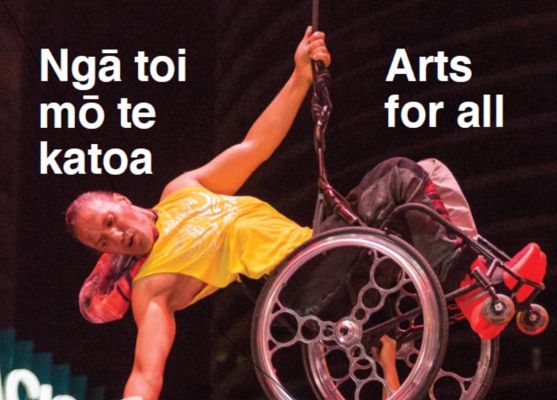Updated Guide To Increasing Arts Accessibility

“I want more than inclusion. I want equity and an arts sector committed to including disability artistry in its annual programme of works rather than a tick-box measure or one-off accessible performance,” says Pelenakeke Brown, one of a dozen artists, practitioners and accessibility advocates profiled in the recently published third edition of Ngā Toi mō te katoa: Arts For All.
Arts For All is a practical guide providing information and tools to encourage arts and cultural organisations, venues, artists and producers to improve their accessibility. It’s complemented by additional online resources such as guidelines, checklists, case studies, information sheets and directories.
The national Arts For All Network, inspired by the publication of this guide in 2009, is a partnership programme between Arts Access Aotearoa and Creative New Zealand.
Stace Robertson, Access, Inclusion and Participation Advisor, Arts Access Aotearoa says that since Arts For All was first published, there has been significant progress and increased opportunities for disabled people to engage in arts and cultural activities and events.
There are now six regional Arts For All Networks around the country: in Auckland, Taranaki, Hawke’s Bay, Wellington, Canterbury and Otago. Members meet face-to- face and online to share information and expertise.
“These regional networks, which we facilitate, have driven much of this change,” Stace says. “They’ve provided opportunities for arts organisations to learn about how to increase accessibility, share knowledge and network with communities.
“This has resulted in a range of accessible initiatives incorporating New Zealand Sign Language, audio description, relaxed events, accessible information and improved physical access.
“This year, I’m excited by the possibilities of working with the networks to help ensure Deaf and disabled artists have equal opportunities to perform and create.”
Judith Jones, an audio describer and a tour guide at Te Papa Tongarewa, has been a member of the Arts For All Wellington Network for five years. In the guide, she writes: “The chance to connect with others with a similar focus is an invaluable part of my overall understanding of access and inclusion in the arts.
“I really like the opportunity the network meetings provide to stop and reflect on the mahi we’re all doing in a collaborative setting.”
Arts For All has eight chapters, covering topics such as appropriate language about disability; how to engage with Deaf and disabled communities; developing and implementing accessibility policies and training; marketing and communications; accessibility in galleries, museums and live performance; and the opportunities provided by digital media.
The guide can be downloaded from the Arts For All Network webpage of the Arts Access Aotearoa website, which also includes guidelines, checklists, information sheets and case studies.
The third edition of Ngā Toi mō te katoa: Arts For All was published with support from Creative New Zealand, Pelorus Trust and the Rehabilitation Welfare Trust.


 Health New Zealand: Community And Collaboration Bring New Mental Health Facility Garden To Life
Health New Zealand: Community And Collaboration Bring New Mental Health Facility Garden To Life NZBS: Turn Up The Music, Roll Up Your Sleeve - New Zealand Blood Service Drop The Beats For Donation
NZBS: Turn Up The Music, Roll Up Your Sleeve - New Zealand Blood Service Drop The Beats For Donation School Library Association of NZ Aotearoa: Students Missing Out - New Research Exposes Alarming Disparities Across Aotearoa
School Library Association of NZ Aotearoa: Students Missing Out - New Research Exposes Alarming Disparities Across Aotearoa ANZCA: Health Reforms Raise Fears Of Two-Tier System And Workforce Shortages
ANZCA: Health Reforms Raise Fears Of Two-Tier System And Workforce Shortages Māpura Studios: A Matariki Exhibition At Historic Alberton House
Māpura Studios: A Matariki Exhibition At Historic Alberton House Doc Edge Festival: Finalists For The Doc Edge Awards 2025, an Oscar®-qualifying event
Doc Edge Festival: Finalists For The Doc Edge Awards 2025, an Oscar®-qualifying event